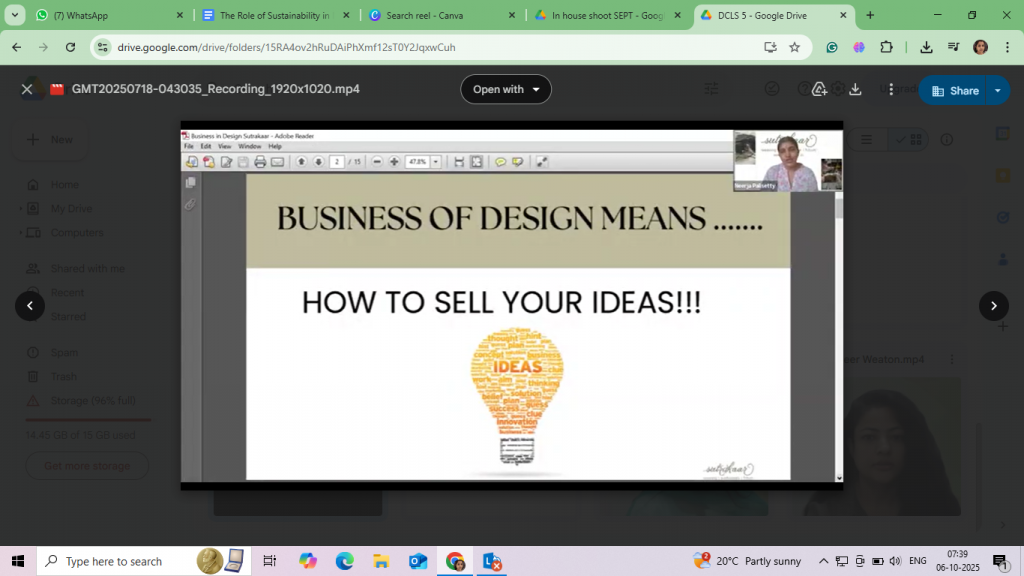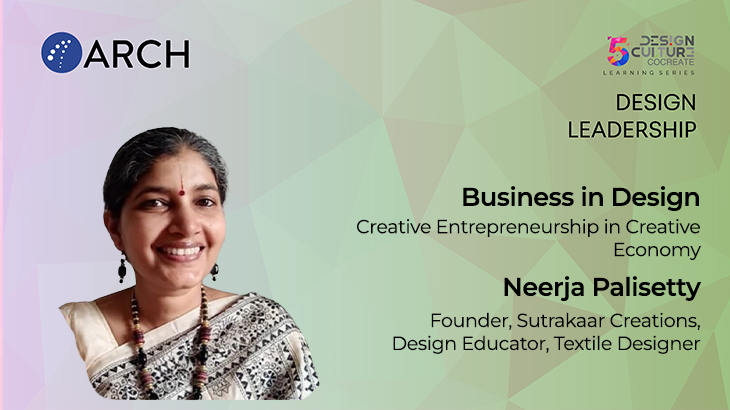In today’s design world, sustainability has become a driving force behind innovation and entrepreneurship. It’s no longer enough for a product to be visually appealing; it must also be meaningful, responsible, and future-oriented. The modern designer is not just a creator of objects but a creator of change, someone who understands that design decisions can influence the planet, the economy, and the way we live.
This idea was brought to life in an insightful session with Neerja Palisetty, founder of Sutrakaar Creations, who has spent over 17 years in the fashion design, textile, and education sectors. Known for her pioneering work in paper weaving, Neerja has built a sustainable business model that transforms discarded paper into handwoven textiles.
In this blog, we explore how sustainability and entrepreneurship can coexist and thrive within the creative economy through her design journey.
Rethinking the Business of Design
The business of design is fundamentally about selling ideas. Every creative concept has the potential to solve a problem or address a need. The challenge for designers is to align creativity with purpose and ensure that their ideas are both marketable and meaningful.
Sustainability strengthens this purpose. It pushes designers to ask crucial questions: Where do my materials come from? How are they made? Who makes them? What happens when the product reaches the end of its life? These questions lead to responsible decision-making and encourage businesses to move beyond short-term profit toward long-term value.

Neerja highlighted that sustainable entrepreneurship means designing products that not only appeal to consumers but also contribute positively to the planet and the people involved in making them.
Turning Waste into Value
One of the most inspiring parts of sustainable design entrepreneurship is the ability to see potential where others see waste. The concept of “turning waste into value” lies at the heart of this mindset. It challenges the traditional idea of consumption—where materials are used, discarded, and forgotten—and instead encourages a circular way of thinking, where every material has a second life.

As Neerja Palisetty shared in her session, waste is not just a by product; it’s an untapped resource waiting to be reimagined through creativity and innovation. Her own brand, Sutrakaar Creations, was born from this realization. She noticed how paper, one of the most widely used and discarded materials, was also among the largest environmental pollutants. Even recycling paper consumes enormous amounts of water and energy. Instead of discarding it, she began to treat paper as a raw material—something that could be spun, woven, and transformed into a textile.
Through research and experimentation, Neerja and her team developed a process of hand-spinning and weaving paper yarn on traditional looms. The result was a collection of textiles that are not only beautiful and durable but also sustainable and meaningful. What was once considered waste became the foundation for fashion accessories, home décor, artworks, and even corporate gifts.
In essence, turning waste into value is about rethinking materials, redefining beauty, and redesigning systems. It is a shift from linear production—make, use, throw—to a circular design approach that sustains both the planet and the people.
You must read: Creativity using Waste Development.
The Art of Balancing Purpose and Profit.
A truly successful design entrepreneur understands that sustainability lies in finding the right balance between creativity, conscience, and commerce. Creativity is the spark — it brings imagination to life, turns raw materials into stories, and gives a brand its soul. Conscience is the compass — it keeps that creativity rooted in ethics, reminding designers that every choice, from material to maker, has an impact. And then there’s commerce — the backbone that turns ideas into livelihoods and dreams into sustainable ventures.

When these three elements move in sync, design becomes far more than aesthetics; it becomes a living, breathing ecosystem. Too much creativity without conscience, and you risk creating beauty that leaves a footprint. Too much conscience without commerce, and your idea may remain a noble dream that never reaches people. But when art, purpose, and practicality find each other, magic happens — design becomes a movement, a story that sustains itself while uplifting others.
Designing for a Conscious Future
Customers today value transparency and care; they want to know the story behind what they buy. Sustainability allows entrepreneurs to build brands that stand for something beyond profit—brands rooted in authenticity, purpose, and connection.

Neerja urged young designers to start early, use resources like incubation centres, and engage with India’s growing startup ecosystem. The key lies in merging creativity with sustainability and business sense. When a design idea addresses a genuine need—whether environmental, social, or emotional—it has the power to grow into a meaningful enterprise.
At ARCH, we believe that the future of design lies in rethinking how creativity, conscience, and commerce come together. Our curriculum goes beyond conventional architecture education — encouraging students to explore sustainability, craft innovation, and design entrepreneurship. Here, learning happens through making, questioning, and collaborating with real communities. Students are guided to see design not just as an art, but as a responsible practice that can drive change and create value.If you’re ready to shape spaces, ideas, and a more sustainable world, join us at ARCH and become a designer who builds with purpose.
